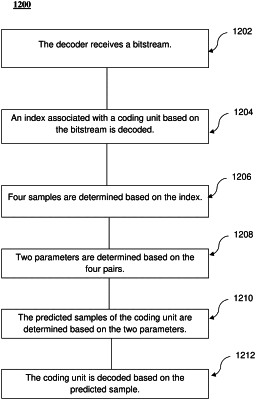| CPC H04N 19/196 (2014.11) [H04N 19/159 (2014.11); H04N 19/184 (2014.11); H04N 19/44 (2014.11)] | 12 Claims |

|
1. A video data processing method, comprising:
receiving a bitstream;
decoding an index associated with a coding unit based on the bitstream, the index indicating a selection mode among at least four selection modes;
determining whether a plurality of top neighboring samples and a plurality of left neighboring samples are available;
determining four samples based on the index;
determining two parameters based on the four samples;
determining predicted samples of the coding unit based on the two parameters; and
decoding the coding unit based on the predicted samples;
wherein determining the four samples based on the index further comprises:
determining the four samples based on an availability of the plurality of the top neighboring samples and the plurality of the left neighboring samples; and
in response to both of the plurality of the top neighboring samples and the plurality of the left neighboring samples being available, determining two of the four samples among the plurality of top neighboring samples and other two of the four samples among the plurality of left neighboring samples;
in response to the plurality of the top neighboring samples being not available and the plurality of the left neighboring samples being available, determining the four samples among the plurality of left neighboring samples; or
in response to the plurality of the top neighboring samples being available and the plurality of the left neighboring samples being not available, determining the four samples among the plurality of top neighboring samples.
|